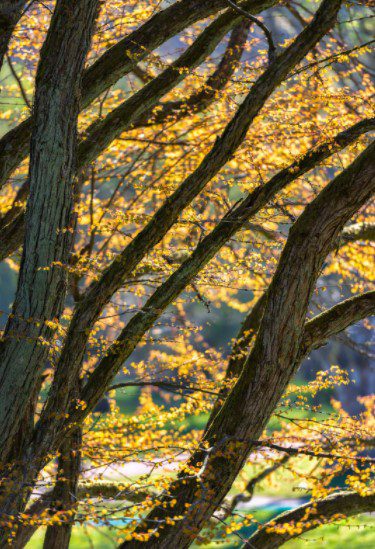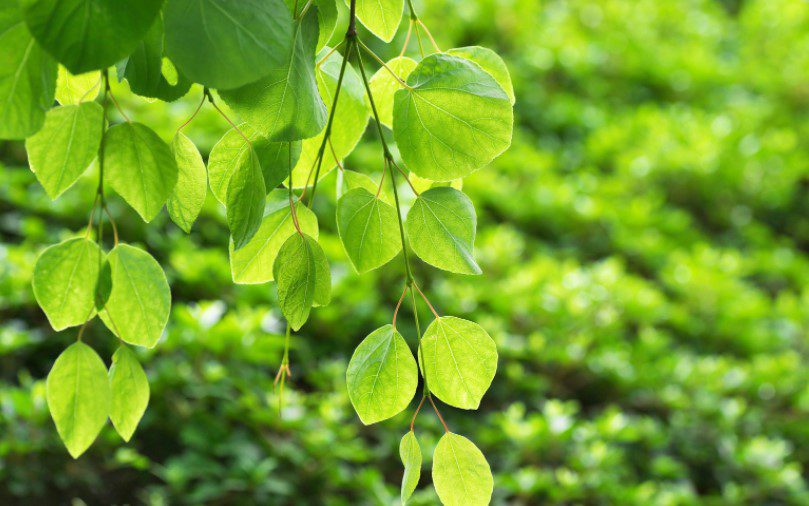Katsura Tree
The Katsura tree is a little-known but excellent shade tree that thrives locally. I am convinced a part of its anonymity is its name.
Appropriately, the tree is a Cercidiphyllum japonica (ser-sid-i-FILL-um JA-PON-i-ca), and no matter how you look at it, that is a mouthful.
The name tells you something — Cercis is the local tree that we call a redbud or Judas tree. The Katsura leaf is shaped like that of the redbud.
The foliage is its beauty; the flowers are almost totally inconspicuous, as are the seeds. In early spring, foliage is apple green with maroon edging.
In summer, it is bright green, and in fall, it glows with foliage of red, salmon pink, tan, and in-between shades. It drops this colorful array in about three days.
How To Spot Katsura Tree
Look for trees with heart-shaped, apricot-colored leaves if you smell the sweet scent of cotton candy while you walk among the turning trees. It is a katsura (Cercidiphyllum japonicum).
The fall scent of dried leaves is a delight. However, katsura tree leaves are sweeter than burnt sugar.
Katsura trees have a distinct sweetness. The scent is stronger when it’s dry. Leaves produce the scent when they stop making chlorophyll and then fall off the trees.
The Arboretum’s 44 Katsura trees produce different aroma intensities, which is common for this species. Variations could be caused by genetics or site conditions.
Katsura tree is not only a fall scent but also has many outstanding aesthetic characteristics throughout the year.

Spring leaves are bronze in color and then turn to blue-green in the summer. Our region’s Katsura tree can grow up to 40-60 feet tall and is multi-stemmed. There are many weeping cultivars.
Red Fox Katsura tree blossoms in deep maroon during spring.
Container-grown katsura plants tend to grow more quickly than those wrapped in burlap and balled.
The katsura tree can be planted in rich, moist soil. If it is not, cankers and stem borers may form. It may tolerate partial shade but prefers full sunlight.
It’s not an urban tree that can be used in parks or areas with clay soil.
Katsura Tree Information
SCIENTIFIC NAME – Cercidiphyllum japonicum
DESCRIPTION – Native to China and Japan, this small shade tree typically grows to 40 feet tall with a dense, pyramidal habit.
It is most noted for its attractive heart-shaped leaves resembling those of a small redbud. Leaves emerge reddish-purple in spring, mature to medium green with a slight bluish tinge in summer, and turn shades of gold, orange and red in autumn.
The fallen autumn leaves emit attractive aromas suggestive of cinnamon, burnt sugar, or ripe apples—a superb, low-maintenance tree for the landscape.
ZONES – 4 to 8
SIZE – 40-60 feet
SUN – Full sun to part shade
WATER – Medium-wet
CARE – Tolerates full sun with ample moisture but is best grown in St. Louis in light shade.
Keep well watered the first few years while it is getting established. Easily maintained as a small tree once established.
ENVIRONMENTAL – Not known to be invasive in the lower Midwest
Growing the Katsura Tree
Katsura trees’ like rich soil means that you should not spare the compost in growing these trees.
By mixing compost into the ground when you plant Katsura trees, you will feed your plants and improve soil drainage.
The Katsura tree is easy to grow, as it can tolerate a variety of things other trees might not.
- Wet soil
- Clay soil
- Acidic soil
- Salt
To help maintain evenly moist soil, it’s a good idea to use mulch around these trees. After planting, mulch should be applied three inches over the ground to retain moisture.
Organic mulches (such as bark mulch) have an added benefit: As they break down, they add different nutrients to the soil and improve its drainage, essential to Katsura trees.
Light
Katsuras are understory trees, meaning they can be grown in partial shade. Even though they are more common in the southerly regions of their range, they can be grown in partial shade to keep their leaves cool in summer. In the North, though, provide them full sun because they achieve better fall-foliage color under these conditions.
Soil
It is essential that the ground be well-drained and retains moisture. The best soil pH is neutral to slightly acid, but the Katsura can tolerate slightly more acidic soil.
Water
Katsuras require moderate watering, but they may need more frequent watering in dry places. It was once established. However, it is quite drought-tolerant. Maintain the soil moist but not wet until the tree becomes established. Then water according to the season.
Humidity and Temperature
This tree is suitable for zones 4-8. It can tolerate extensive temperatures and is not fussy about humidity. Avoid watering overhead in wet seasons or climates to avoid leaf mildew.
Fertilizer
Fertilize katsura trees with a balanced fertilizer. Make sure to soak the soil well after fertilizer application to ensure it reaches the roots.
There are many varieties of Katsura Trees.
- Red Fox Katsura tree ( Cercidiphyllum Japonicum “Rotfuchs”): This tree is smaller than the species tree and stands 30 feet tall. It bears greenish-bronze, purplish-bronze, and orangey bronze fall leaves.
- Weeping KatsuraTree(Cercidiphyllum japonicum ‘ Pendulum’s): Between 15 and 25 feet in height, with a similar or slightly larger spread. The branches of this smaller type are also comparable to the Pendulum. Droop down, increasing visual interest.
Pruning Katsura Trees
Katsuras don’t usually require any pruning other than for seasonal cleanups and maintenance. Each spring, check the tree for suckers and dead branches.
Landscape Uses of Katsura Trees
Although the Katsura tree can be found in many parts of the Orient, it is less well-known in North America. This is a shame because the Katsura tree has some unique features that make it valuable.
It is a superb choice for growers searching for a particular plant to set their yards apart from their neighbors. There is no need to be concerned about it being around dogs or children: Katsura trees can be poisonous to pets and people.
A Katsura tree can be used as a shade tree when a more prominent tree-like sugar maple (Acer saccharum) would be too large.
Its tidy form, attractive leaf shape, and fall color also make it suitable as a specimen. If great fall color is your primary goal, grow the Red Fox cultivar. However, the small weeping Katsura cultivar has the most beautiful form of all the Katsura trees.
Trees similar to Katsura
Cercidiphyllum Japonicum is known as “Katsura.” Cercidiphyllum is the genus name for the Katsura tree.
Its shape is similar to the redbud tree’s (Cercis genera). The arrangement of their leaves on the branches can be used to distinguish the two.
Katsura leaves are placed in pairs, while redbud leaves are in an alternate pattern. The japonicum species name reveals where the Katsura is found.


























